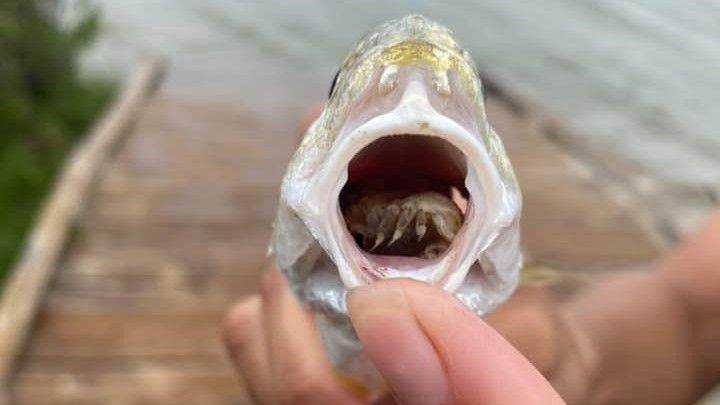
In any relationship, there's usually one partner that does the heavy lifting.
In the case of one alien-looking parasitic isopod, that's the female, who has the tough job of gobbling up a fish's tongue and replacing it with her own body. The male, meanwhile, takes the easy route and simply hangs out in a fish's gills, eating mucus all day.
A recent photo captured this disturbing parasitic relationship in the mouth of an Atlantic croaker (Micropogonias undulatus) caught in Galveston Island State Park in Texas. The fish's tongue had been completely replaced by this so-called tongue-eating louse.
Though unsettling, such parasitic encounters are far from rare. These creepy creatures routinely feed on fish in warm waters worldwide, including the Gulf of Mexico, as several commenters noted on Galveston Island State Park's Facebook post. As members of the order Isopoda, they are nightmarish cousins of the roly-poly pill bugs found in many backyards, Mark Fisher, science director at the Texas Parks and Wildlife Department, told Texas news outlet KSAT.
Related: 8 awful parasite infections that will make your skin crawl
There are several species of tongue-eating lice, the most well-known of which (Cymothoa exigua) inspired the 2012 horror flick The Bay, according to AAAS. Many species target one particular type of fish, the same way tropical moths have evolved to feed on specific orchids, according to research published in 2014 in the International Journal for Parasitology. Fisher told members of the press that he had never seen one in an Atlantic croaker before, NPR reported.
When a group of juvenile isopods finds a fish, the critters swim into the fish's gills and latch on with their spiky, clawed legs. At this point in their life cycle, all of the isopods are male — but one louse will grow larger than the rest, make its way into the fish's mouth and become female. There, she will attach herself to the blood vessels at the base of the tongue and feed until the tongue rots away.
Fortunately, the parasites have no interest in human tongues. And despite the ick factor, they don't seem to substantially harm the fish they call home, according to PBS' NOVA. Instead, the fish simply uses its parasite like a prosthetic tongue, and fish can live with these parasitic interlopers for years, Live Science previously reported. Meanwhile, the female isopod continues to chow down on its host's blood and mouth mucus, while the males stay in the gills, occasionally sneaking into the fish's mouth to mate with its new faux tongue.
So, if you're looking for a fright this Halloween, consider fishing. "It can be a surprise to peer into a fish's mouth and have another set of eyes looking back at you," Fisher said.
Originally published on Live Science.
"fish" - Google News
October 29, 2021 at 06:00PM
https://ift.tt/3CrmOQl
'Tongue-eating' lice invade fish's mouth in this year's creepiest Halloween photo - Livescience.com
"fish" - Google News
https://ift.tt/35JkYuc
https://ift.tt/3feFffJ
Bagikan Berita Ini















0 Response to "'Tongue-eating' lice invade fish's mouth in this year's creepiest Halloween photo - Livescience.com"
Post a Comment